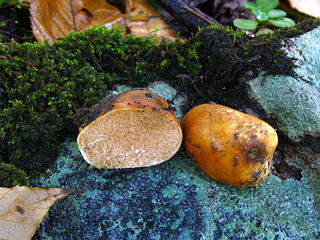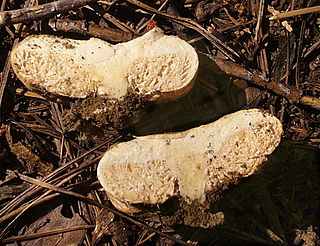
The Russulaceae are a diverse family of fungi in the order Russulales, with roughly 1,900 known species and a worldwide distribution. They comprise the brittlegills and the milk-caps, well-known mushroom-forming fungi that include some edible species. These gilled mushrooms are characterised by the brittle flesh of their fruitbodies.

Lactarius is a genus of mushroom-producing, ectomycorrhizal fungi, containing several edible species. The species of the genus, commonly known as milk-caps, are characterized by the milky fluid ("latex") they exude when cut or damaged. Like the closely related genus Russula, their flesh has a distinctive brittle consistency. It is a large genus with over 500 known species, mainly distributed in the Northern hemisphere. Recently, the genus Lactifluus has been separated from Lactarius based on molecular phylogenetic evidence.

Afroboletus is a genus of fungi in the family Boletaceae. The genus, circumscribed in 1981, contains seven species found in tropical Africa.

Lactifluus volemus, formerly known as Lactarius volemus, and commonly known as the weeping milk cap or bradley, is a species of fungus in the family Russulaceae. It is widely distributed in the northern hemisphere, in temperate regions of Europe, North America and Asia as well as some subtropical and tropical regions of Central America and Asia. A mycorrhizal fungus, its fruit bodies grow on the ground at the base of various species of trees from summer to autumn, either individually or in groups. It is valued as an edible mushroom, and is sold in markets in Asia. Several other Lactifluus mushrooms resemble L. volemus, such as the closely related edible species L. corrugis, but these can be distinguished by differences in distribution, visible morphology, and microscopic characteristics. L. volemus produces a white spore print and has roughly spherical spores about 7–8 micrometres in diameter.

Lactarius glyciosmus, commonly known as the coconut scented milk cap, is a semi-edible mushroom in the genus Lactarius. Mycorrhizal, it can be found growing in soil at the base of birch trees in Europe. It is typically coloured a greyish lilac, with the sometimes hollow stem a little lighter coloured than the cap. It has crowded, decurrent gills, and smells strongly of coconuts.

Lactarius vietus is a species of fungus in the family Russulaceae, first described by Elias Magnus Fries. It produces moderately sized and brittle mushrooms, which grow on the forest floor or on rotting wood. The flattened-convex cap can vary in shape, sometimes forming the shape of a wide funnel. It is typically grey, but the colour varies. The species has crowded, light-coloured gills, which produce white milk. The spore print is typically whitish, but also varies considerably. The mushrooms typically have a strong, acrid taste and have been described as inedible, but other authors have described them as consumable after boiling. L. vietus feeds by forming an ectomycorrhizal relationship with surrounding trees, and it favours birch. It grows in autumn months and is fairly common in Europe, North America and eastern Asia.

Multifurca is a rare genus of ectomycorrhizal fungi in the family Russulaceae. It was described in 2008, after molecular phylogenetic study had shown that it forms a monophyletic lineage within the family, sister to Lactarius. The genus contains six species known from the United States, Mexico, Costa Rica, India, China, Thailand, Australia, and New Caledonia, but so far has not been reported from Europe, Africa, or South America. Four of those species were formerly classified as Russula section Ochricompactae, and Multifurca furcata was originally described as a Lactarius species.

Zelleromyces is a genus of fungi in the family Russulaceae. It was first described by mycologists Rolf Singer and Alexander H. Smith in 1960 to contain hypogeous (underground) fungi with gasteroid fruit bodies that "bleed" latex when they are cut.

Lactarius kabansus is a member of the large milk-cap genus Lactarius in the order Russulales. Described as new to science in 1980, the species is found in Zambia. This is a popular edible mushroom in Zambia which is found in the rainy season from December through February. It is prepared by rinsing with salt to remove soil and frying. Amanita zambiana and Lactarius kabansus are two of the most popular edible mushrooms in Zambia.
Amanita zambiana, commonly known as the Zambian slender Caesar, is a basidiomycete fungus in the genus Amanita. An edible mushroom, it is found in Africa, where it is commonly sold in markets.
Lactifluus densifolius is a species of agaric fungus in the family Russulaceae. It is found in Zambia, where it grows in miombo woodland.
Lactifluus aureifolius is a species of agaric fungus in the family Russulaceae. It is found in Burundi, which grows in miombo woodland dominated by Brachystegia utilis. The fungus was described in 1996 as a species of Lactarius.
Russula campinensis is a neotropical species in the genus Russula. This species is highly different from most other known Russula species in that it has very small (2–17 mm), pleurotoid fruitbodies that develop on tree trunks in up to 2 m elevation from the forest floor. It was described as Lactarius campinensis from Brazil (Amazonas) by Rolf Singer. T.W. Henkel, M.C. Aime and S.L. Miller later found this species in tropical rainforest of the Pakaraima Mountains, Guyana, and showed with molecular phylogenetic methods that it belongs to Russula. Although forming fruitbodies on wood, R. campinensis is a root-symbiotic ectomycorrhizal species and has been observed in Guyana associated with Dicymbe altsonii and D. jenzenii trees in the legume subfamily Caesalpinioideae.

Arcangeliella is a genus of gasteroid fungi in the family Russulaceae. Taxonomic and phylogenetic research has shown that it is very likely a synonym of Lactarius. The type species Arcangeliella borziana was moved to Lactarius in 2003. However, the genus name is still in use for several species for which new combinations have not yet been proposed.

Arcangeliella crassa is a North American secotioid fungus species in the family Russulaceae. Like other members of its genus, it should probably be transferred to the genus Lactarius. It was described from a collection made in Stanislaus National Forest, Northern California.

Zelleromyces cinnabarinus is a North American gasteroid fungus species in the family Russulaceae with a cinnabar-red peridium. It is the type species of Zelleromyces, and like other members of its genus, it should probably be transferred to the genus Lactarius which it belongs to phylogenetically. It was described from a collection made under pine in Jackson, Louisiana.

Lactifluus clarkeae, formerly known as Lactarius clarkeae, is a species of mushroom-forming fungus in the family Russulaceae. It is found in Australia and New Zealand in mycorrhizal association with species of Nothofagus and the family Myrtaceae.
Lactarius baliophaeus is a member of the large milk-cap genus Lactarius in the order Russulales. Described as new to science by mycologist David Pegler in 1969, the species is found in Ghana, Benin, and Zambia. Fruitbodies of the type collection were found growing in the ground under Cassia. It is closely related to Lactarius subbaliophaeus, a species described from Togo in 2014. Both are classified in Lactarius section Nigrescentes. L. baliophaeus is edible and used as food.
David Norman Pegler is a British mycologist. Until his retirement in 1998, he served as the Head of Mycology and assistant keeper of the herbarium at the Royal Botanic Gardens in Kew. Pegler received his BSc from London University in 1960, thereafter studying tropical Agaricales with R.W.G. Dennis as his graduate supervisor. He earned a master's degree in 1966, and a PhD in 1974. His graduate thesis was on agarics of east Africa, later published as A preliminary agaric flora of East Africa in 1977. In 1989, London University awarded him a DSc for his research into the Agaricales.










